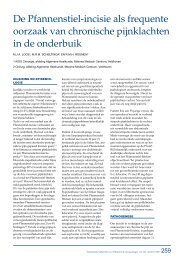Surgical management of chronic inguinal pain syndromes - Liespijn
Surgical management of chronic inguinal pain syndromes - Liespijn
Surgical management of chronic inguinal pain syndromes - Liespijn
You also want an ePaper? Increase the reach of your titles
YUMPU automatically turns print PDFs into web optimized ePapers that Google loves.
presence <strong>of</strong> a normal cutaneous sensation. Patients usually report an increase in local<strong>pain</strong> if pressure is applied to the mesh by the palpating fingers <strong>of</strong> the investigator.A combined <strong>pain</strong> syndrome entailing neuropathic and nociceptive elements is notuncommon.An early study on nerve entrapment after a Pfannenstiel incision was published in thelate 1980’s 12 . The pathogenesis <strong>of</strong> ‘post-Pfannenstiel <strong>pain</strong>’ is thought similar comparedto postherniorrhaphy <strong>pain</strong>. A (too) lateral dissection beyond the border <strong>of</strong> the abdominalrectus muscle may lead to nerve damage causing neuroma formation <strong>of</strong> the ilio<strong>inguinal</strong>or iliohypogastric nerve 7 . Moreover, constricting sutures or development <strong>of</strong>postoperative fibrosis can also induce nerve entrapment with an identical neuropathic<strong>pain</strong> syndrome. The genit<strong>of</strong>emoral nerve is <strong>of</strong>ten beyond the operated area and is usuallynot affected after Pfannenstiel incisions.Management <strong>of</strong> <strong>pain</strong> <strong>syndromes</strong> after <strong>inguinal</strong> or Pfannenstiel incisionsStudies on diagnosing <strong>chronic</strong> postherniorrhaphy <strong>inguinal</strong> <strong>pain</strong> <strong>syndromes</strong> are few 11 .In 2004 Amid published his findings on computed tomography as a tool in diagnosingdisplaced and rolled-up prosthetic material (so-called ‘meshoma’) 13 . He concluded thatthis radiologic modality can be useful in unravelling <strong>chronic</strong> <strong>pain</strong> after <strong>inguinal</strong> herniarepair. A few years later, the role <strong>of</strong> Magnetic Resonance Imaging in diagnosing specificpathogenic mechanisms in <strong>chronic</strong> postherniorrhaphy <strong>inguinal</strong> <strong>pain</strong> was analyzed. Theauthors concluded that the inter-observer agreement is low and that MRI-assessedpathology is not necessarily related to persistent postherniotomy <strong>pain</strong> 14 .Evidence concerning adequate treatment options for <strong>chronic</strong> <strong>inguinal</strong> <strong>pain</strong> <strong>syndromes</strong>is also limited. Non-surgical treatment options including peripheral nerve blocks,analgesics (e.g. antidepressants or anticonvulsants), Transcutaneous Electric NerveStimulation (TENS), and Pulsed Radio Frequency (PRF) for <strong>chronic</strong> postherniorrhaphy<strong>inguinal</strong> <strong>pain</strong> have been used for a limited number <strong>of</strong> patients 15-20 . Most reported caseswere successful suggesting publication bias. Moreover, surgery including <strong>inguinal</strong> neurectomyfor neuropathic <strong>pain</strong> is incidentally reported 10,11,21-25 . Consensus on an optimaltreatment strategy has not been reached 26 .Studies on <strong>chronic</strong> <strong>pain</strong> after a Pfannenstiel incision are rare. Very few studies on effectivetreatment regimes for <strong>chronic</strong> <strong>pain</strong> after a Pfannenstiel incision have been published 27 .GENERAL AIM OF THIS THESISTo study <strong>management</strong> <strong>of</strong> <strong>chronic</strong> <strong>pain</strong> <strong>syndromes</strong> after <strong>inguinal</strong> hernia repair andPfannenstiel incisions in a general patient population.SPECIFIC AIMS1. To quantify the overall prevalence <strong>of</strong> <strong>chronic</strong> <strong>pain</strong> and functional impairment after<strong>inguinal</strong> hernia repair and Pfannenstiel incisions.2. To assess which <strong>pain</strong> measurement tool, Visual Analogue Scale (VAS) or a VerbalRating Scale (VRS), performs best in postherniorrhaphy <strong>pain</strong> patients.3. To classify <strong>chronic</strong> <strong>inguinal</strong> <strong>pain</strong> after <strong>inguinal</strong> hernia repair and Pfannenstiel incisions.4. To assess the long-term results <strong>of</strong> <strong>inguinal</strong> neurectomy for <strong>pain</strong> <strong>syndromes</strong> after<strong>inguinal</strong> hernia repair and Pfannenstiel incisions.5. To describe the socio-economic consequences <strong>of</strong> <strong>chronic</strong> neuropathic postherniorrhaphy<strong>pain</strong> and the influence <strong>of</strong> surgical treatment strategies on occupational disability ina cohort <strong>of</strong> <strong>pain</strong> patients.OUTLINEChronic <strong>pain</strong> as a complication after routine <strong>inguinal</strong> hernia repair is increasinglyrecognized as a major problem. However, incidence in an average post-hernia repairpopulation in the Netherlands is hardly known. The prevalence <strong>of</strong> long-term <strong>chronic</strong><strong>pain</strong>, numbness and functional impairment after open and laparoscopic <strong>inguinal</strong>hernia repair was studied using a novel questionnaire. Results <strong>of</strong> this investigation arereported in chapter 2.A Pfannenstiel incision may initiate similar postoperative <strong>pain</strong> <strong>syndromes</strong> compared toan <strong>inguinal</strong> hernia repair. In chapter 3, prevalence, risk factors and etiology <strong>of</strong> ‘post-Pfannenstiel<strong>pain</strong> <strong>syndromes</strong>’ in a large patient cohort are investigated.Several tools for <strong>pain</strong> measurement including a Visual Analogue Scale (VAS) and aVerbal Rating Scale (VRS) are currently used in various patient populations with <strong>chronic</strong><strong>pain</strong>. Objective <strong>of</strong> the study in chapter 4 was to determine which <strong>of</strong> these two <strong>pain</strong>measurement scales performs optimal in <strong>chronic</strong> <strong>pain</strong> patients following <strong>inguinal</strong>hernia repair.Chronic postherniorrhaphy <strong>pain</strong> is diverse in origin. The study described in chapter 512 Chapter 1Introduction, aims and outline 13





